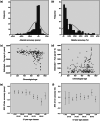Automated age-at-death estimation by cementochronology: Essential application or additional complication?
- PMID: 36790742
- PMCID: PMC9804312
- DOI: 10.1002/ajpa.24612
Automated age-at-death estimation by cementochronology: Essential application or additional complication?
Abstract
It has been repeatedly acknowledged that age-at-death estimation based on dental cementum represents a partial and time-consuming method that hinders adoption of this histological approach. User-friendly micrograph analysis represents a growing request of cementochronology. This article evaluates the feasibility of using a module to accurately quantify cementum deposits and compares the module's performance to that of a human expert. On a dental collection (n = 200) of known-age individuals, precision and accuracy of estimates performed by a developed program (101 count/tooth; n = 20,200 counts) were compared to counts performed manually (5 counts/tooth; n = 975 counts). Reliability of the software and agreement between the two approaches were assessed by intraclass correlation coefficient and Bland Altman analysis. The automated module produced reliable and reproducible counts with a higher global precision than the human expert. Although the software is slightly more precise, it shows higher sensitivity to taphonomic damages and does not avoid the trajectory effect described for age-at-death estimation in adults. Likewise, for human counts, global accuracy is acceptable, but underestimations increase with age. The quantification of the agreement between the two approaches shows a minor bias, and 94% of individuals fall within the intervals of agreement. Automation gives an impression of objectivity even though the region of interest, profile position and parameters are defined manually. The automated system may represent a time-saving module that can allow an increase in sample size, which is particularly stimulating for population-based studies.
Keywords: age‐at‐death; automation; cementochronology; dental cementum.
© 2022 The Authors. American Journal of Biological Anthropology published by Wiley Periodicals LLC.
Conflict of interest statement
The authors declare that there are no conflicts of interest regarding the publication of this article.
Figures







References
-
- Bertrand, B. (2013). Procedure ISO‐9001—Cementochronologie, référence: MOP‐Dap‐04, Indice a.
Publication types
MeSH terms
LinkOut - more resources
Full Text Sources
